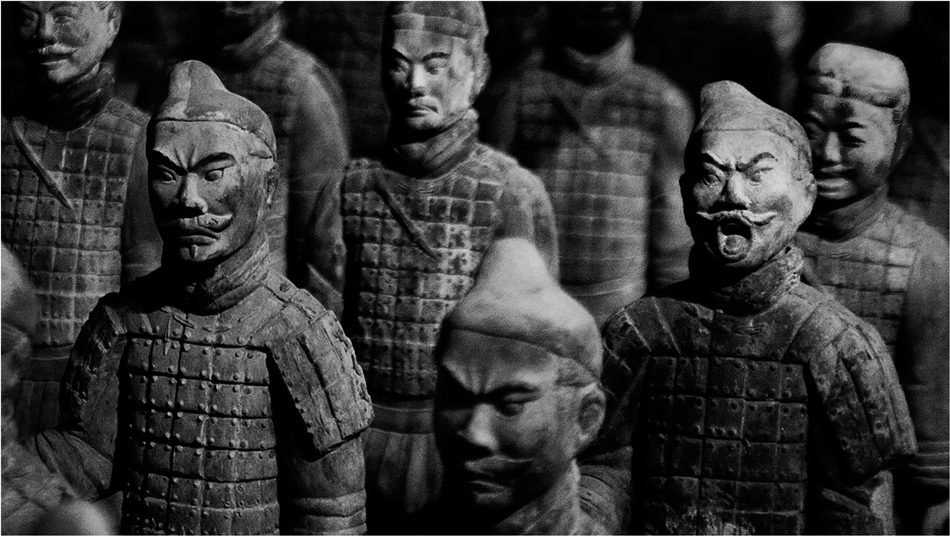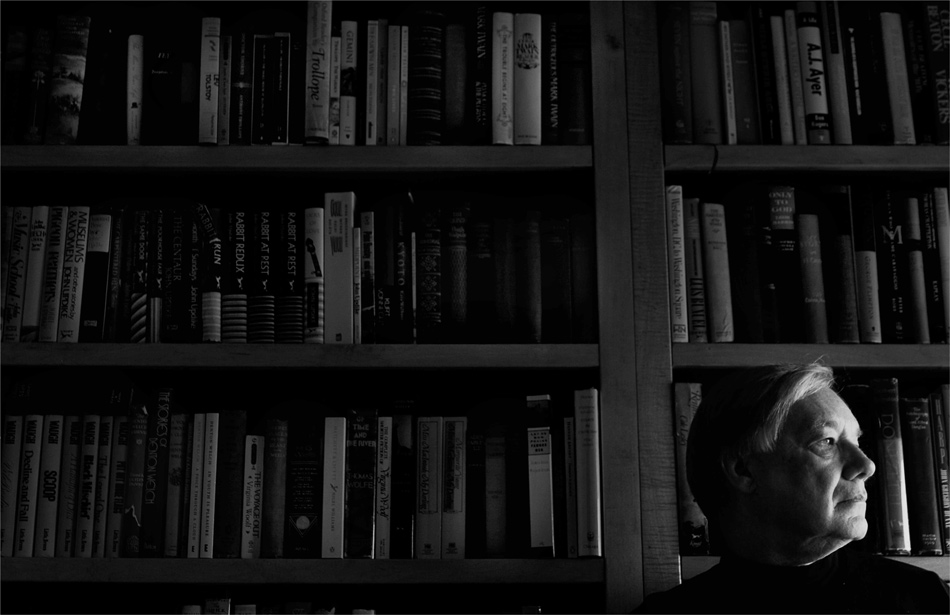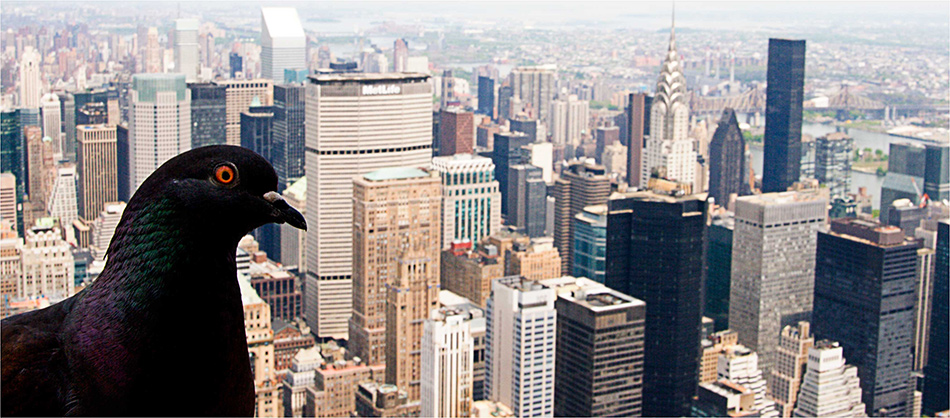Directing the Eye Part 5 - Putting It All Together by Thann Clark
We have covered the psychological elements that naturally direct the eye:
faces,
eyes,
pattern interruption,
text and the visual elements:
contrast,
color,
focus, and
size.

How you put them together is entirely up to you. This is where your unique voice and vision come into play, and I am reluctant to give much advice here beyond this: The more you stack these techniques on top of one another, the more the eye will be compelled to look where you want. To that point, here is an example of how I used these techniques in a portrait.

This is a portrait of my father, a man obsessed with books. Books are on practically every surface in his house, there are even book cases in the garage. This is the bookcase in the guest bedroom. His head is small in relation to the books, because I want to tell the story of a man surrounded by books. You are compelled to look at his head because it breaks the vertical/horizontal pattern of books and shelves. But also his head is where the most contrast is in the image so you are pulled there. It is also where the focus is. So I combined pattern interruption with contrast and focus, to draw your eye to him. A competing factor in this image was text. With all of those books, the eye would be naturally drawn to the titles, so I lowered the contrast and toned down the books. I stacked and enhanced elements to draw you to my subject, while lowering the impact of competing elements in the environment. The result is an image where the eye is compelled to look where I want.

What could be more obvious than a pigeon in New York? So how is the eye being directed here? The curves of the pigeon interrupt the patterns made by the skyscrapers. The pigeon is in focus, while the buildings are slightly soft. The pigeon has vibrant colors; the background does not. Also the bird?s eye is the area of greatest contrast, so we will naturally look there. The portrait of my father and the pigeon photo both direct the eye in similar ways, but the are fundamentally different in a very important way. The portrait was an image I imagined, then created. The pigeon shot I ?found? while out photographing. In the portrait I was
controlling what was happening, in the other I was
reacting. The point is: if you know how to
control these elements in a photograph, you will do a better job of
finding them. If you understand how to direct the eye, and stack the elements together, you will recognize better ?photos? when you see them in the wild. You will adjust your camera and your angle, and stronger shots will come faster to you. The first step is to become aware of the elements that draw the eye, hopefully these articles have helped. The next step is to put them into action, and figure out how ? and if ? they work for you. All images ©Thann Clark Be sure to check out the first four blogs in this series:
Directing the Eye Part 1: Psychological Elements Directing the Eye Part 2: Contrast and Color Directing the Eye Part 3: Focus Directing the Eye Part 4: Size
 How you put them together is entirely up to you. This is where your unique voice and vision come into play, and I am reluctant to give much advice here beyond this: The more you stack these techniques on top of one another, the more the eye will be compelled to look where you want. To that point, here is an example of how I used these techniques in a portrait.
How you put them together is entirely up to you. This is where your unique voice and vision come into play, and I am reluctant to give much advice here beyond this: The more you stack these techniques on top of one another, the more the eye will be compelled to look where you want. To that point, here is an example of how I used these techniques in a portrait.  This is a portrait of my father, a man obsessed with books. Books are on practically every surface in his house, there are even book cases in the garage. This is the bookcase in the guest bedroom. His head is small in relation to the books, because I want to tell the story of a man surrounded by books. You are compelled to look at his head because it breaks the vertical/horizontal pattern of books and shelves. But also his head is where the most contrast is in the image so you are pulled there. It is also where the focus is. So I combined pattern interruption with contrast and focus, to draw your eye to him. A competing factor in this image was text. With all of those books, the eye would be naturally drawn to the titles, so I lowered the contrast and toned down the books. I stacked and enhanced elements to draw you to my subject, while lowering the impact of competing elements in the environment. The result is an image where the eye is compelled to look where I want.
This is a portrait of my father, a man obsessed with books. Books are on practically every surface in his house, there are even book cases in the garage. This is the bookcase in the guest bedroom. His head is small in relation to the books, because I want to tell the story of a man surrounded by books. You are compelled to look at his head because it breaks the vertical/horizontal pattern of books and shelves. But also his head is where the most contrast is in the image so you are pulled there. It is also where the focus is. So I combined pattern interruption with contrast and focus, to draw your eye to him. A competing factor in this image was text. With all of those books, the eye would be naturally drawn to the titles, so I lowered the contrast and toned down the books. I stacked and enhanced elements to draw you to my subject, while lowering the impact of competing elements in the environment. The result is an image where the eye is compelled to look where I want.  What could be more obvious than a pigeon in New York? So how is the eye being directed here? The curves of the pigeon interrupt the patterns made by the skyscrapers. The pigeon is in focus, while the buildings are slightly soft. The pigeon has vibrant colors; the background does not. Also the bird?s eye is the area of greatest contrast, so we will naturally look there. The portrait of my father and the pigeon photo both direct the eye in similar ways, but the are fundamentally different in a very important way. The portrait was an image I imagined, then created. The pigeon shot I ?found? while out photographing. In the portrait I wascontrolling what was happening, in the other I was reacting. The point is: if you know how to control these elements in a photograph, you will do a better job of finding them. If you understand how to direct the eye, and stack the elements together, you will recognize better ?photos? when you see them in the wild. You will adjust your camera and your angle, and stronger shots will come faster to you. The first step is to become aware of the elements that draw the eye, hopefully these articles have helped. The next step is to put them into action, and figure out how ? and if ? they work for you. All images ©Thann Clark Be sure to check out the first four blogs in this series: Directing the Eye Part 1: Psychological Elements Directing the Eye Part 2: Contrast and Color Directing the Eye Part 3: Focus Directing the Eye Part 4: Size
What could be more obvious than a pigeon in New York? So how is the eye being directed here? The curves of the pigeon interrupt the patterns made by the skyscrapers. The pigeon is in focus, while the buildings are slightly soft. The pigeon has vibrant colors; the background does not. Also the bird?s eye is the area of greatest contrast, so we will naturally look there. The portrait of my father and the pigeon photo both direct the eye in similar ways, but the are fundamentally different in a very important way. The portrait was an image I imagined, then created. The pigeon shot I ?found? while out photographing. In the portrait I wascontrolling what was happening, in the other I was reacting. The point is: if you know how to control these elements in a photograph, you will do a better job of finding them. If you understand how to direct the eye, and stack the elements together, you will recognize better ?photos? when you see them in the wild. You will adjust your camera and your angle, and stronger shots will come faster to you. The first step is to become aware of the elements that draw the eye, hopefully these articles have helped. The next step is to put them into action, and figure out how ? and if ? they work for you. All images ©Thann Clark Be sure to check out the first four blogs in this series: Directing the Eye Part 1: Psychological Elements Directing the Eye Part 2: Contrast and Color Directing the Eye Part 3: Focus Directing the Eye Part 4: Size






